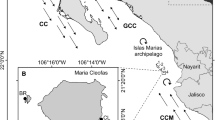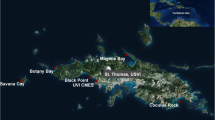Abstract
Recovery of Acropora palmata from its currently imperiled status depends on recruitment, a process which is poorly documented in existing Caribbean coral population studies. A. palmata is thought to be well adapted to proliferate through the recruitment of fragments resulting from physical disturbances, such as moderate intensity hurricanes. This study monitored fifteen 150 m2 fixed study plots on the upper Florida Keys fore-reef for asexual and sexual recruitment from 2004 to 2007. Between July and October 2005, 4 hurricanes passed by the Florida Keys, producing wind speeds on the reef tract of 23 to 33 m s−1. Surveys following the hurricanes documented an average loss of 52% estimated live tissue area within the study plots. The percentage of “branching” colonies in the population decreased from 67% to 42% while “remnant” colonies (isolated patches of tissue on standing skeleton) increased from 11% to 27%. Although some detached branches remained as loose fragments, more than 70% of the 380 fragments observed in the study plots were dead or rapidly losing tissue 3 weeks after Hurricane Dennis. Over the course of the study, only 27 fragments became attached to the substrate to form successful asexual recruits. Meanwhile, of the 18 new, small encrusting colonies that were observed in the study, only 2 were not attributable to asexual origin (i.e., remnant tissue from colonies or fragments previously observed) and are therefore possible sexual recruits. In summary, the 2005 hurricane season resulted in substantial loss of A. palmata from the upper Florida Keys fore-reef from a combination of physical removal and subsequent disease-like tissue mortality, and yielded few recruits of either sexual or asexual origin. Furthermore, the asexual and sexual fecundity of the remaining population is compromised for the near future due to the lack of branches (i.e., “asexual fecundity”) and overall loss of live tissue.






Similar content being viewed by others
References
Bak RPM (1983) Neoplasia, regeneration and growth in the reef-building coral Acropora palmata. Mar Biol 77:221–227
Bak RPM, Criens SR (1982) Experimental fusion in Atlantic Acropora (Scleractinia). Mar Biol Lett 3:67–72
Baums IB, Miller MW, Szmant AM (2003) Ecology of a corallivorous gastropod, Coralliophila abbreviata, on two scleractinian hosts. I: population structure of snails and corals. Mar Biol 142:1083–1091
Baums IB, Miller MW, Hellberg ME (2005) Regionally isolated populations of an imperiled Caribbean coral, Acropora palmata. Mol Ecol 14:1377–1390
Bonito V, Grober-Dunsmore R (2006) Resheeting of relict Acropora palmata framework may promote fast growth, but does it compromise the structural integrity of the colony? Coral Reefs 25:46
Bruckner AW (2002) Proceedings of the Caribbean Acropora workshop: potential application of the US Endangered Species Act as a conservation strategy. NOAA Technical Memorandum NMFS-OPR-24
Bythell J, Pan P, Lee J (2001) Three-dimensional morphometric measurements of reef corals using underwater photogrammetry techniques. Coral Reefs 20:193–199
Coffroth MA, Lasker HR (1998) Population structure of a clonal gorgonian coral: the interplay between clonal reproduction and disturbance. Evolution 52:379–393
Connell JH (1978) Diversity in tropical rain forests and coral reefs. Science 1999:1302–1310
Douhovnikoff V, McBride JR, Dodd RS (2005) Salix exigua clonal growth and population dynamics in relation to disturbance regime variation. Ecology 86:446–452
Fadlallah YH (1983) Sexual reproduction, development and larval biology in scleractinian corals. Coral Reefs 2:129–150
Fagan WF, Holmes EE (2006) Quantifying the extinction vortex. Ecol Lett 9:51–60
Fong P, Lirman D (1995) Hurricanes cause population expansion of the branching coral Acropora palmata (Scleractinia): wound healing and growth patterns of asexual recruits. Mar Ecol 16:317–335
Gardner TA, Cote IM, Gill JA, Grant A, Watkinson AR (2005) Hurricanes and Caribbean coral reefs: impacts, recovery patterns, and role in long-term decline. Ecology 86:174–184
Gilpin ME, Soulé ME (1986) Minimum viable populations: processes of species extinction. In: Soulé ME (ed) Conservation biology: the science of scarcity and diversity. Sinauer Associates, Sunderland, pp 19–34
Grober-Dunsmore R, Bonito V, Frazer TK (2006) Potential inhibitors to recovery of Acropora palmata populations in St. John, US Virgin Islands. Mar Ecol Prog Ser 321:123–132
Highsmith RC (1982) Reproduction by fragmentation in corals. Mar Ecol Prog Ser 7:207–226
Highsmith RC, Riggs AC, Dantonio CM (1980) Survival of hurricane-generated coral fragments and a disturbance model of reef calcification/growth rates. Oecologia 46:322–329
Honnay O, Bossuyt B (2005) Prolonged clonal growth: escape route or route to extinction? Oikos 108:427–432
Hughes TP, Tanner JE (2000) Recruitment failure, life histories, and long-term decline of Caribbean corals. Ecology 81:2250–2263
Jordan-Dahlgren E (1992) Recolonization patterns of Acropora palmata in a marginal environment. Bull Mar Sci 51:104–117
Kojis BL, Quinn NJ (2001) The importance of regional differences in hard coral recruitment rates for determining the need for coral restoration. Bull Mar Sci 69:967–974
Lirman D (2000) Fragmentation in the branching coral Acropora palmata (Lamarck): growth, survivorship, and reproduction of colonies and fragments. J Exp Mar Biol Ecol 251:41–57
Lirman D (2003) A simulation model of the population dynamics of the branching coral Acropora palmata—effects of storm intensity and frequency. Ecol Model 161:169–182
Lirman D, Fong P (1997) Patterns of damage to the branching coral Acropora palmata following Hurricane Andrew: damage and survivorship of hurricane-generated asexual recruits. J Coast Res 13:67–72
Lugo AE, Rogers CS, Nixon S (2000) Hurricanes, coral reefs and rainforests: resistance, ruin and recovery in the Caribbean. Ambio 29:106–114
McFadden CS (1997) Contributions of sexual and asexual reproduction to population structure in the clonal soft coral, Alcyonium rudyi. Evolution 51:112–126
Miller MW, Baums IB, Williams DE, Szmant AM (2002a) Status of Candidate coral, Acropora palmata, and its snail predator in the upper Florida Keys National Marine Sanctuary: 1998–2001. NOAA Technical Memorandum NMFS-SEFSC-479
Miller MW, Jaap WC, Chiappone M, Vargas Angel B, Keller BD, Aronson RB, Shinn EA (2002b) Acropora corals in Florida: status, trends, conservation, and prospects for recovery. In: Bruckner AW (ed) Proceedings of the Caribbean Acropora workshop: potential application of the US Endangered Species Act as a conservation strategy: April 16–18, 2002, Miami, Florida. NOAA Technical Memorandum NMFS-OPR-24, pp 59–70
Miller MW, Baums IB, Williams DE (2007) Visual discernment of sexual recruits not feasible for Acropora palmata. Mar Ecol Prog Ser 335:227–231
NMFS (2006) Endangered and threatened species: final listing determinations for Elkhorn coral and Staghorn coral. Federal Register 71:26852–26861
Quinn NJ, Kojis BL (2005) Patterns of sexual recruitment of acroporid coral populations on the West Fore Reef at Discovery Bay, Jamaica. Rev Biol Trop 53(Suppl 1):83–89
Reusch TBH, Ehlers A, Hammerli A, Worm B (2005) Ecosystem recovery after climatic extremes enhanced by genotypic diversity. Proc Natl Acad Sci USA 102:2826–2831
Rogers CS, Fitz HCI, Gilnack M, Hardin J (1984) Scleractinian coral recruitment patterns at Salt River Submarine Canyon, St. Croix, U.S. Virgin Islands. Coral Reefs 3:69–76
Schmid B (1994) Effects of genetic diversity in experimental stands of Solidago altissima: evidence for the potential role of pathogens as selective agents in plant-populations. J Ecol 82:165–175
Shinn EA, Salomonson VV, Bhavsar PD (1980) Geologic history of Grecian Rocks, Key Largo Coral Reef Marine Sanctuary. Bull Mar Sci 30:646–656
Soong K, Lang JC (1992) Reproductive integration in reef corals. Biol Bull 183:418–431
Van Moorsel GWNM (1988) Early maximum growth of stony corals (Scleractinia) after settlement on artificial substrata on a Caribbean reef. Mar Ecol Prog Ser 50:127–135
Van Moorsel GWNM (1989) Juvenile ecology and reproductive strategies of reef corals. Ph.D. thesis, Rijksuniversiteit Groningen, p 104
Voss GL (2002) An environmental assessment of the John Pennekamp Coral Reef State Park and the Key Largo Coral Reef Marine Sanctuary (Unpublished 1983 Report). In: Voss NA, Cantillo AY, Bello MJ (eds) NOAA/University of Miami Joint Publication NOAA Technical Memorandum NOS NCCOS CCMA 161
Williams DE, Miller MW (2005) Coral disease outbreak: pattern, prevalence and transmission in Acropora cervicornis. Mar Ecol Prog Ser 301:119–128
Williams DE, Miller MW (2006) Importance of disease & predation to the growth & survivorship of juvenile Acropora palmata & Acropora cervicornis: a demographic approach. Proc 10th Int Coral Reef Symp 1:1096–1104
Williams DE, Miller MW, Kramer KL (2006) Demographic monitoring protocols for threatened Caribbean Acropora spp. corals NOAA Technical Memorandum NMFS-SEFSC-543
Zubillaga AL, Bastidas C, Croquer A (2005) High densities of the Elkhorn coral Acropora palmata in Cayo de Agua, Archipelago Los Roques National Park, Venezuela. Coral Reefs 24:86–86
Acknowledgments
This study was made possible by the NOAA-Coral Reef Conservation Program and the National Undersea Research Center at the University of North Carolina-Wilmington and was conducted under Florida Keys National Marine Sanctuary permits # FKNMS-2004-12, 2006-12. Field assistance was provided by C. Fasano, L. Johnston, B. Mason, M. Beard. Helpful discussions and comments from D. Lirman, C. Rogers, and T. Vardi are gratefully acknowledged.
Author information
Authors and Affiliations
Corresponding author
Additional information
Communicated by Ecology Editor Prof. Peter Mumby.
Rights and permissions
About this article
Cite this article
Williams, D.E., Miller, M.W. & Kramer, K.L. Recruitment failure in Florida Keys Acropora palmata, a threatened Caribbean coral. Coral Reefs 27, 697–705 (2008). https://doi.org/10.1007/s00338-008-0386-3
Received:
Revised:
Accepted:
Published:
Issue Date:
DOI: https://doi.org/10.1007/s00338-008-0386-3




